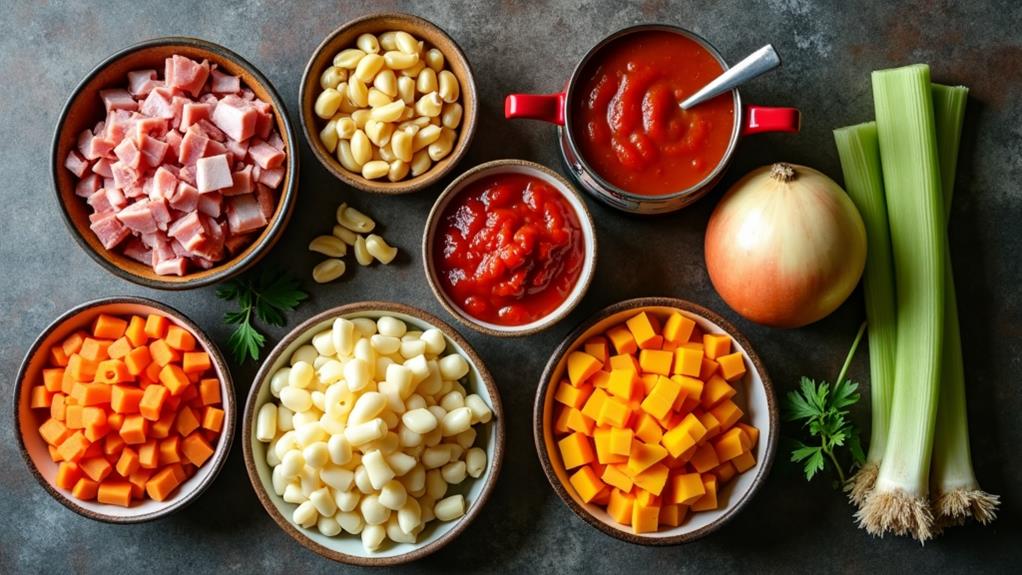When you think of a warm, nourishing dish to combat the winter chill, Winter Minestrone likely comes to mind. This soup, with its roots in humble beginnings, offers a canvas for seasonal vegetables and hearty beans, making each bowl a comforting experience. You might find it interesting how this dish has transformed over time, reflecting the culinary traditions of different regions. But what truly sets it apart is its adaptability to various dietary needs, ensuring everyone can enjoy its rich flavors. Let's explore the elements that make this soup not just a meal, but a celebration of winter's bounty.
Key Takeaways
- Winter Minestrone is a hearty soup featuring seasonal vegetables, beans, pasta, and pancetta for a filling meal perfect for cold months.
- The recipe is customizable, allowing the use of available produce and accommodating various dietary preferences.
- Key ingredients include diced pancetta, onion, carrots, celery, butternut squash, broth, crushed tomatoes, cannellini beans, and small pasta.
- This soup can be prepared in advance, with flavors deepening overnight, and it freezes well for later enjoyment.
- Serve Winter Minestrone with olive oil, Parmesan cheese, fresh herbs, and crusty bread for a comforting meal.
History
The rich history of minestrone showcases resilience and creativity in Italian cooking. This hearty winter dish, which literally means "to stir," began as a peasant meal crafted from whatever beans and vegetables were at hand.
Imagine families in Italy during the Renaissance, combining local produce with spices and meats, all driven by seasonal availability and a spirit of frugality. They turned scraps into something nourishing, embracing a culinary philosophy that still resonates today.
As time went on, minestrone evolved, becoming a staple of Italian cuisine that thrived in the cold months. Packed with legumes and seasonal vegetables, it's a nutritional powerhouse, aligning perfectly with the Mediterranean diet.
Each region in Italy has put its own spin on minestrone, leading to delightful regional variations that reflect local tastes and ingredients.
Today, as global interest in Italian cuisine expands, minestrone continues to adapt, incorporating diverse cultural influences while maintaining its core essence.
Whether you're enjoying a traditional bowl or a modern interpretation, the spirit of innovation and resourcefulness remains at the heart of this beloved dish.
Recipe

Winter Minestrone
Winter Minestrone is the perfect recipe to warm you up during the chilly months. This hearty soup isn't only delicious but also packed with nutrition, making it an ideal choice for a nourishing meal. Featuring a medley of seasonal vegetables, beans, and pasta, it's both filling and satisfying. The addition of pancetta adds a rich depth of flavor, while the vibrant colors of the vegetables make for a visually appealing dish.
Making Winter Minestrone is a straightforward process that allows you to customize the ingredients based on what you have on hand or your dietary preferences. Whether you opt for the classic version with pancetta or choose a vegetarian alternative, this soup is sure to become a favorite in your kitchen. Serve it with a drizzle of olive oil, a sprinkle of Parmesan cheese, and a handful of fresh herbs for an extra touch of flavor.
Ingredients:
- 4 oz pancetta, diced
- 1 onion, chopped
- 2 carrots, diced
- 2 celery stalks, diced
- 1 cup butternut squash, diced
- 4 cups chicken broth (or vegetable broth for a vegetarian option)
- 1 can (14 oz) crushed tomatoes
- 1 can (15 oz) cannellini beans, drained and rinsed
- 1 cup small pasta (like ditalini or elbow)
- Salt and pepper to taste
- Olive oil, for drizzling
- Fresh parsley or basil, chopped, for garnish
- Grated Parmesan cheese, for serving
In a large pot, heat a splash of olive oil over medium heat. Add the diced pancetta and cook until it starts to crisp. Then, add the chopped onion, carrots, celery, and butternut squash, sautéeing until the vegetables are softened.
Pour in the chicken broth and crushed tomatoes, bringing the mixture to a simmer. Stir in the cannellini beans and pasta, cooking until the pasta is al dente, about 10-12 minutes. Season with salt and pepper to taste, then remove from heat.
For the best results, consider using fresh, seasonal vegetables to enhance the flavor and nutrition of your Winter Minestrone. You can also prepare the soup ahead of time, as it stores well in the refrigerator for a few days. Reheat gently on the stove, adding a splash of water or broth if it thickens too much.
Additionally, feel free to experiment with different types of beans or pasta to suit your taste preferences.
Similar dishes to explore include Italian Ribollita, a hearty Tuscan bread soup, or a classic Vegetable Soup that can also incorporate various vegetables and legumes. Each of these dishes offers a comforting and nutritious meal option, perfect for any cold winter day.
Final Notes
When making Winter Minestrone, keep in mind that this soup not only warms you up but also offers a chance to get creative in the kitchen. This hearty soup can be your canvas, allowing you to mix and match seasonal vegetables.
Try using diced pancetta for a savory kick or switch it up with some meaty mushrooms. Don't forget the cannellini beans and Swiss chard, as they add both texture and nutrition.
To enhance the flavors, sauté your aromatics in a splash of olive oil and toss in a Parmesan rind while it simmers. When you bring the soup to a boil, let it bubble away until those veggies become tender.
Remember, Winter Minestrone is perfect for making ahead! It freezes well for up to a month, and the flavors deepen overnight in the fridge, making your next meal even more delightful.
When serving, drizzle some olive oil, sprinkle grated Parmesan cheese, and add fresh herbs for that finishing touch. Pair it with crusty bread, and you've got a satisfying meal that's not just comforting but also bursting with innovation.
Enjoy the creativity and warmth this soup brings!
